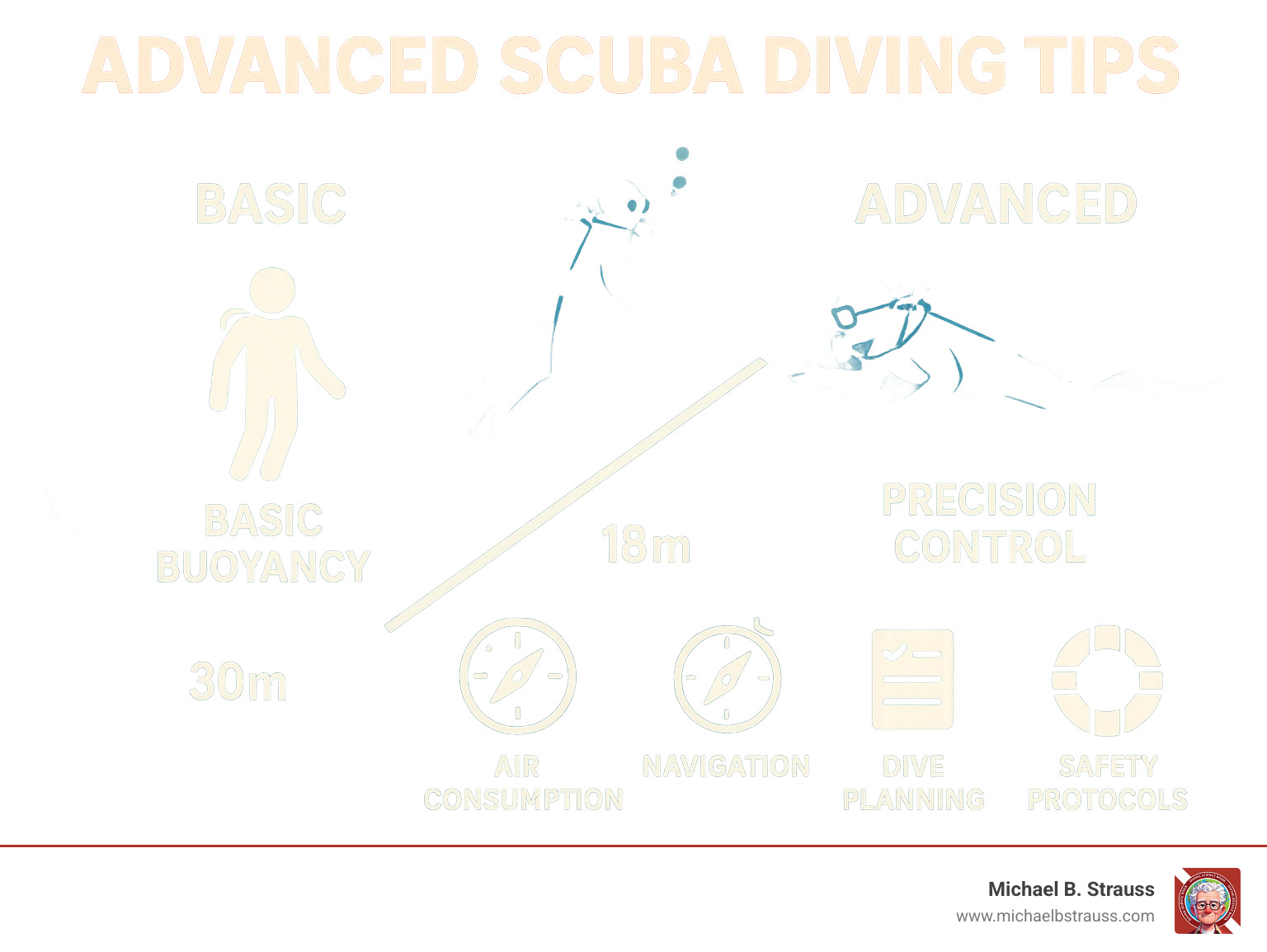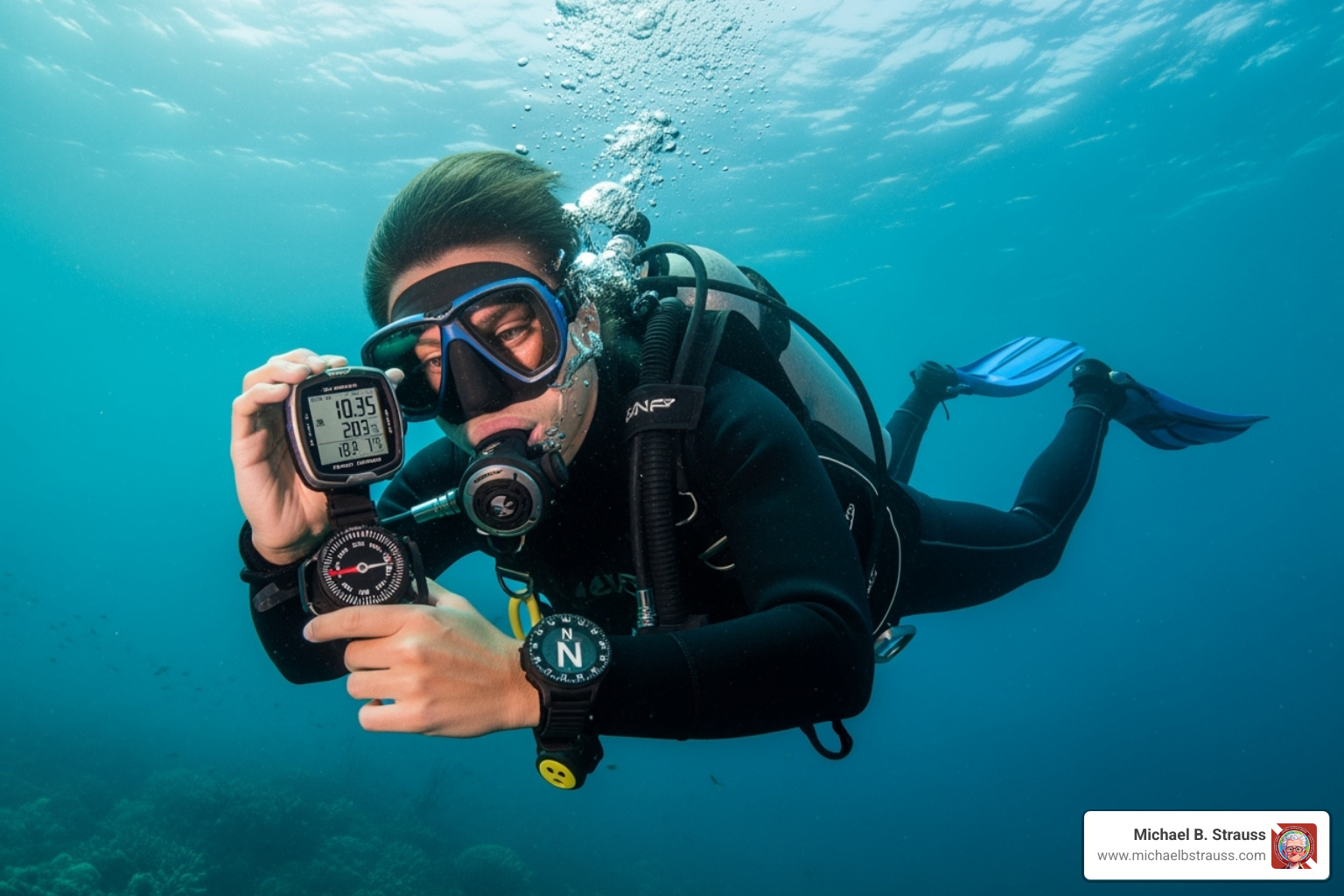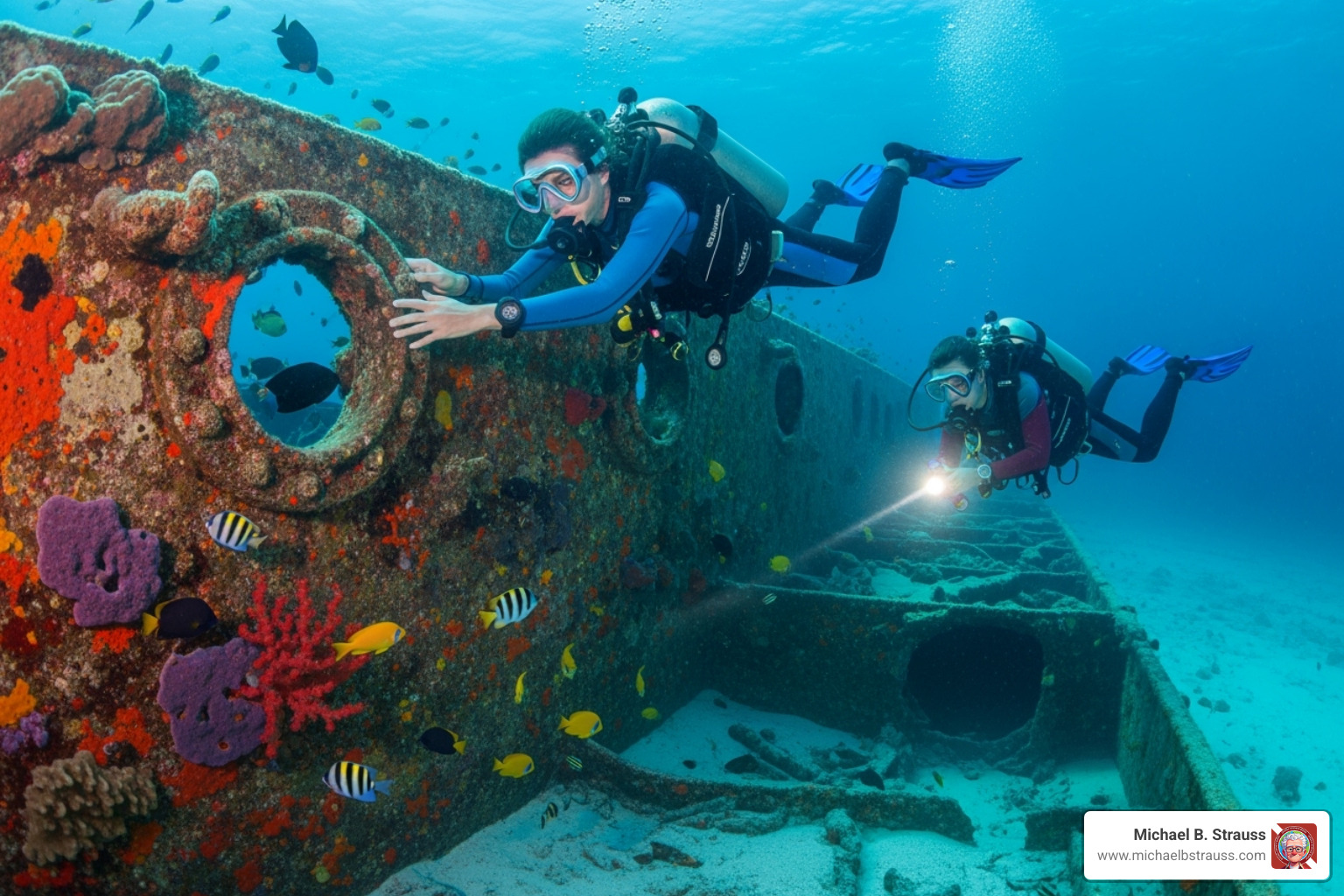Why Advanced Scuba Diving Skills Matter for Safe and Confident Diving
Advanced scuba diving tips can transform your underwater experience, taking you from basic exploration to confident, skilled diving. Knowing when you're ready for advanced diving is crucial for safety and enjoyment, whether you're eyeing deeper dives or just want to improve your technique.
Quick Answer: Key Advanced Scuba Diving Tips
- Master neutral buoyancy - Control depth without constant BCD adjustments.
- Perfect your finning - Use frog kicks, back kicks, and helicopter turns efficiently.
- Improve air consumption - Breathe slowly and deeply; maintain horizontal trim.
- Steer confidently - Use compass skills and natural references.
- Plan thoroughly - Calculate gas needs, set turn pressures, and understand NDLs.
- Know your gear - Be familiar with all equipment before advanced dives.
- Practice situational awareness - Constantly monitor depth, time, air, and your buddy.
Many divers rush into advanced diving without mastering the fundamentals. As one professional noted, "good buoyancy control is what separates the novices from the expert scuba divers." Advanced diving isn't just about depth; it's about precision, confidence, and handling challenges calmly. At 30 meters, you use air four times faster than at the surface, making every skill critical. An honest self-assessment is key. Can you hover motionless? Do you finish dives with ample air? These skills are essential for more demanding dives.

Basic Advanced scuba diving tips terms:
Beyond the Basics: Are Your Core Skills Truly Advanced?
When we talk about advanced scuba diving tips, we mean a genuine mastery of foundational skills, not just a certification card. The true mark of an advanced diver is refined control over buoyancy, breathing, and finning, coupled with sharp environmental awareness. As Dr. Michael B. Strauss emphasizes in his comprehensive diving books, true safety comes from skill and preparedness.
Mastering correct breathing, body position, and finning are the bedrock of all advanced scuba diving tips. Your logbook is a key tool for this, helping you track air consumption, weight requirements, and equipment servicing.
Buoyancy is often the most difficult skill to master, and poor control is a contributing factor in many diving incidents. Many divers are also overweighted, which complicates buoyancy and increases air consumption. Being an advanced diver is a blend of honed skills, experience, and confidence. Improving skills like buoyancy and finning directly leads to better air consumption and dive efficiency.
Refining Your Buoyancy and Breathing: Key Advanced Scuba Diving Tips
Neutral buoyancy is the holy grail of diving, allowing you to glide effortlessly while conserving energy and air. It's the foundation for all other advanced scuba diving tips. Achieving it relies on controlling your weighting, BCD, and breath.
Your lungs are a primary tool for buoyancy control. A bigger breath makes you more buoyant, while exhaling makes you sink. Using your lungs for these micro-adjustments is a hallmark of an advanced diver. This relates to Archimedes Principle and our body's natural interaction with water, a concept explored in Mammalian Diving.
Proper weighting is the starting point. Most new divers are overweighted, forcing them to constantly adjust their BCD. The goal is to be neutrally buoyant at your safety stop with a nearly empty tank. Make small weight adjustments (1-2 lbs) and give them time to take effect.
Your wetsuit also affects buoyancy, compressing at depth and requiring you to add air to your BCD. As you ascend, this air expands, so you must vent it in short bursts to maintain control. Maintaining a horizontal trim is also vital for reducing drag and conserving energy.
Finally, proper breathing conserves air, maintains buoyancy, and controls movement. Slow, deep breaths are key. Your lungs can create a significant buoyancy shift, but with normal breathing, the change is small, allowing for fine-tuning. At 30 meters, your no-stop limit is shorter and you'll use air four times faster, making efficient breathing absolutely crucial.
Mastering Finning Techniques and Air Consumption
Efficient finning is another cornerstone of advanced scuba diving tips. It conserves energy, reduces air consumption, and protects the marine environment. For more, explore More on Diving Science.
Advanced divers use specialized kicks beyond the basic flutter kick:
- Frog kick: A powerful, efficient kick that avoids stirring up silt.
- Helicopter turn: Allows for precise 360-degree rotations in place.
- Back kick: Essential for moving backward in confined spaces like wrecks or caves.
Streamlining your body by keeping it horizontal reduces drag and helps you glide effortlessly.
Mastering air consumption is a common goal. Deeper dives consume more air due to increased density; at 33 feet, you use twice the air as at the surface. However, advanced divers learn to breathe more efficiently at depth, as each breath contains more oxygen. The key is to breathe slowly and deeply for optimal gas exchange, not to hold your breath. This simple change can make a huge difference in your bottom time.
Mastering the Mindset: Essential Advanced Scuba Diving Tips for Planning and Awareness
The difference between a good diver and an advanced one often lies in the mental preparation before a dive. Advanced scuba diving tips are not just about physical skills; they're about the discipline and planning that ensure safety and confidence.

Your logbook becomes a personal database for tracking air consumption, weighting needs, and gear service dates. This data is invaluable for planning challenging dives. Also, never underestimate the importance of feeling well. If you're not 100%, whether from stress or fatigue, it's wise to sit out a dive. The buddy check (BCD, Weights, Releases, Air, Final Okay) is a non-negotiable safety net, and listening to dive briefings is crucial, as conditions can always change.
Best Practices for Underwater Navigation and Situational Awareness
Getting lost underwater is dangerous and exhausting. Advanced scuba diving tips for navigation combine compass skills with natural cues.
Practice using your compass and supplement it by counting kick cycles to estimate distance. Pay attention to natural navigation cues: light direction, changes in the bottom composition, and even how fish orient themselves in a current. Understanding how water moves around structures is critical when diving in strong currents. Developing this intuitive feel for the environment, or Water Serendipity: My Aquatic Savoir-Faire, improves both safety and enjoyment.
Situational awareness is a constant mental scan of your no-stop time, gas supply, environment, equipment, depth, navigation, and buddy. The buddy system requires active communication and mutual responsibility. If a problem arises, remember the priority: "Dive First, Situation Second, Communicate Third." Handle your own position first, then address the issue, then signal your buddy.
Effective Gear Management and Dive Planning
As an advanced diver, your gear becomes an extension of yourself. Gear familiarity is non-negotiable for challenging dives.
Your pre-dive checks should be thorough: verify dive computer settings, check BCD inflator response, and ensure your regulator breathes easily. Know your gear and your buddy's. For complex dives, redundancy is key. This might mean a pony bottle for backup air, extra cutting tools, or a backup mask. Using a reel is essential for navigating inside wrecks.
Dive planning becomes more detailed. You must establish a turn pressure (typically one-third of your air) before the dive. Understanding No Decompression Limits (NDLs) is critical for deeper dives. While your computer tracks this, knowing the principles of Decompression Science helps you make safer decisions.
Follow the rule of thirds for air management: one-third out, one-third back, and one-third in reserve. Finally, diligent equipment maintenance, including rinsing and regular servicing, is crucial, especially when diving in remote locations.
The Path Forward: Continuous Learning and Exploration
A diver's journey is one of continuous learning and exploration. Becoming an Advanced Open Water Diver is a fantastic next step that opens up new experiences and deepens your underwater knowledge.

Courses like the PADI Advanced Open Water Diver are designed to build skills and confidence with an instructor. You'll complete five dives, with Deep and Navigation dives typically being required due to their importance. This certification qualifies you to dive up to 30 meters (100 feet), and each trip dive can often count toward a specialty certification. This continuous learning boosts your skills, confidence, and access to more challenging sites.
Why Further Training and Specialty Skills Matter
Pursuing further training is one of the most critical advanced scuba diving tips. It expands your limits and opens doors to incredible new dive sites. The Advanced Open Water course isn't necessarily "harder" than the initial certification; it's about gaining experience under professional supervision.
Consider these popular specialties to transform your diving:
Deep Diving: Learn to safely plan and execute dives up to the recreational limit of 40 meters (130 feet), managing factors like nitrogen narcosis. Learn more about the risks at Why and at What Sites Decompression Sickness Can Occur.
Wreck Diving: Teaches specialized navigation and safety protocols for exploring sunken structures. A key tip: always use a reel to trace your path.
Enriched Air (Nitrox): Allows for longer no-stop bottom times by using air with a higher oxygen content.
Peak Performance Buoyancy: Refines your buoyancy to an expert level, helping you conserve air and protect marine life.
Night Diving: Covers the unique procedures and equipment for exploring the underwater world after dark.
Other specialties like Dry Suit Diver or Underwater Photography also offer exciting new skills and experiences, making you a more capable and adventurous diver.
Diving Responsibly: Safety, Conservation, and Your Next Steps
As your skills advance, so does your responsibility for safety and marine conservation. These are paramount advanced scuba diving tips.
For overhead environments like wrecks and caves, always seek certified training. Never attempt these dives without it. Safety requires redundant systems, such as triple light sources and independent backup air for cave diving. Dr. Michael B. Strauss's diving books offer essential knowledge on preventing and managing diving medical problems, which you can learn more about in Evaluation and Management of Pain-Related Medical Problems of Diving.
Advanced divers are also guardians of the ocean. Live by the principle: "take only photos, leave only bubbles." Excellent buoyancy control is key to avoiding damage to fragile marine ecosystems.
The journey to becoming an advanced diver never ends. Continuously practice your skills, seek new training, and learn from every dive. To continue your journey with expert guidance, explore our diving Resources. By embracing these tips, you become a better diver and an ambassador for the underwater world.
To take your diving knowledge to the next level, get your copy of Diving Science, Revisited.
DISCLAIMER: Articles are for "EDUCATIONAL PURPOSES ONLY", not to be considered advice or recommendations.






